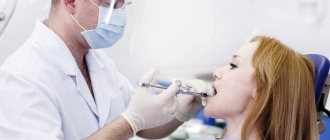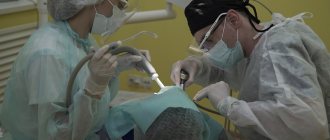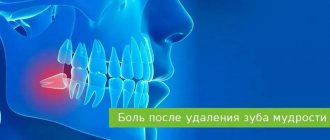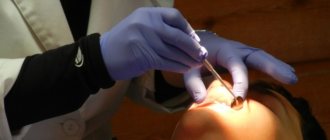Usually, the healing of the hole after tooth extraction occurs painlessly and does not cause any sensations in the patient. It would be good if everyone knew how this process works and how to speed it up.
Proper oral care after tooth extraction and following all the dentist’s recommendations will help speed up the healing of the hole and avoid complications.
Stages of socket healing by day
- The bleeding that occurs after tooth extraction stops after a few minutes , and a blood clot is formed that protects the wound from the penetration of microbes. Under the clot, damaged tissue is being restored, so it is so important to maintain its integrity until the hole heals completely.
- Day 1 – the processes of epithelization (healing) of the wound surface begin.
- Day 3 - signs of epithelization become noticeable, healing begins from the edges of the wound and moves towards the center.
- Day 4 - granulation tissue begins to form - a type of connective tissue that is formed in the body only during wound healing by secondary intention, when there is a strong defect in the skin.
- Day 7 - granulation tissue replaces part of the blood clot, it remains only in the center of the hole. Osteoid (bone) beams begin to appear, indicating bone formation. At the same time, epithelial tissue grows significantly from the edges of the gums.
- 14th -18th day - epithelization of the wound is completely completed, its surface is tightened and heals completely. By this time, the hole is completely filled with granulation tissue, and osteoid tissue is actively developing.
- After a month, a significant part of the hole is filled with new bone tissue. By the end of the second, sometimes third month, this process is completely completed.
- 4th month - bone beams in the newly formed osteoid tissue calcify, it matures: it becomes spongy and does not differ from the rest of the bone. At the same time, the edges of the socket dissolve, the alveolar edge in the area of the extracted tooth becomes thinner and lower than it was before surgery.
Diseases that cause gum pain
Unfortunately, no one is immune from unpleasant consequences after tearing out a root unit. Much depends on metabolism (metabolism), existing chronic pathologies, age, the functioning of the immune system, the tendency to develop allergies - a huge number of factors influence the regeneration processes.
It is necessary to consider whether the person is taking any medications. After all, there are medications that inhibit the formation of a blood clot, prevent blood from clotting quickly, or increase blood pressure. All of these effects are unacceptable during recovery from extraction.
Among the main diseases causing complications after extraction:
- Periostitis. Inflammatory lesion of the periosteum. Most often it occurs due to immunodeficiency or advanced chronic pathologies of the oral cavity. It can also be triggered by hidden infections localized in the maxillofacial area. Periostitis causes inflammation of the soft tissues after the root unit is pulled out. A person’s body temperature rises and their general health worsens. He becomes lethargic and weak. At the same time, the cheek swells. To slow down the inflammatory process and reverse it as soon as possible, combined anti-inflammatory and antimicrobial therapy and oral sanitation are carried out. If the disease has spread to deep-lying tissues, the patient is most often hospitalized in a hospital to avoid abscess and phlegmon of the jaw.
- Alveolitis. Inflammation of the walls of the alveoli after surgery. The disease occurs when tissue healing is slow, there are necrotic areas, or an “empty” socket. First there is pain, then it is accompanied by bad breath. In the area of the torn unit, a light gray coating characteristic of pathology appears. It is difficult to remove. Therapy includes frequent washing of the wound with an antiseptic solution and oral administration of anti-inflammatory drugs selected by a specialist.
Considering the seriousness of these diseases, it is important to treat extraction responsibly. During the preparation period, you should undergo treatment of all existing pathologies of the oral cavity and high-quality sanitation and professional hygiene.
Healing of the socket with gum inflammation
If tooth extraction was carried out against the background of inflammation, or the inflammatory process in the gums developed later, epithelization of the wound begins on the 10th -14th day, bone beams appear only by the 15th day. A significant part of the socket is filled with young osteoid tissue only by the end of the second month.
After a complex tooth extraction, when the gums rupture and the walls of the socket are traumatized, the edges of the gums cannot come together for a long time and the epithelization process slows down. Wound healing can only be completed after 1-1.5 months. In this case, the development of new bone tissue is delayed.
Why do my gums hurt after tooth extraction?
Extraction is a serious intervention. The further the destroyed unit is located in the row, the more roots it has, the denser the bone, the more difficult it is to pull it out. It is especially difficult for a dental surgeon if the coronal part is significantly destroyed. Then you have to remove the sharp fragments.
If a granuloma is detected at the apex or there is an accumulation of pus in the capsule, two successive operations may be required - the first is aimed at removal, the second is aimed at washing out purulent masses and sanitation. Doctors often scrape out necrotic tissue from a bleeding socket. All these procedures contribute to additional trauma to the mucous membranes. It is not surprising that the patient experiences soreness during the healing period.
How to speed up the healing of a hole
To speed up the healing of the hole after tooth extraction, you need to follow these rules:
- Do not touch the blood clot on the socket with your tongue, much less with your hands or a toothpick, so as not to damage it. The presence of a clot is a guarantee of speedy healing of the wound.
- For three hours after visiting the dentist, you should not eat or rinse your mouth. Compliance with this point will also help maintain the integrity of the blood clot.
- · Drinks and food should not be too hot or cold for several days after removal. The food chosen is soft, without coarse inclusions, to prevent injury to the gums.
- You should not engage in heavy physical work for several days to avoid opening the wound and resuming bleeding.
- Since tobacco smoke and alcohol irritate the mucous membrane and inhibit the healing of the hole, you need to stop smoking and drinking alcohol for a while.
- To prevent infection from entering the wound and reduce inflammation after a traumatic tooth extraction, antiseptic baths are used. For them, solutions of chlorhexidine or furatsilin, infusions of sage, chamomile, and eucalyptus are used. The solutions are taken into the mouth, held for several minutes and carefully spat out.
- On the third day after removal, you can carry out antiseptic rinses with the same agents.
- Taking anti-inflammatory drugs (nimesulide, ibuprofen) will help not only eliminate pain, but also relieve the inflammatory process, which also helps accelerate socket regeneration.
- If the doctor has prescribed antibiotics, you should not refuse them, since eliminating the microbial infection shortens the healing time.
- When brushing your teeth, be careful not to touch the wound with the brush.
- To speed up healing, you can use Solcoseryl dental paste. It enhances intracellular energy exchange, due to which cell regeneration and restoration of damaged tissues are accelerated. Solcoseryl also creates conditions for the growth of granulation tissue. The paste is applied to a previously dried surface, then moistened with water. Before using the medicine, it would be more correct to ask your dentist about when to start using Solcoseryl after tooth extraction and how many times a day to apply it to the gums.
How to treat gums at home
The basic rule of home therapy is to follow all medical prescriptions. If there is a special anti-inflammatory medicine in the inflamed area, you should not remove it without permission due to the unpleasant taste or odor. The doctor will do this himself or will tell you exactly the day and time when it is necessary to remove the medicated compress.
Dentists often prescribe soda baths. To carry them out, you need to mix a teaspoon of baking soda with a glass of warm water. Keep the solution in your mouth without rinsing. This simple measure helps to quickly remove the purulent exudate.
It is very important to follow a gentle diet during the recovery period. If there is severe pain on the first day after surgery, it is permissible to take a painkiller. If the medicine does not help or reduces the uncomfortable symptoms only slightly, you should definitely seek qualified help.
A good healing effect is provided by antibacterial gels and ointments designed specifically for treating gums. They must be prescribed by a dental surgeon.
If the operation was difficult and the likelihood of postoperative complications is high, the doctor may prescribe oral antibiotics. Typically, dentists prefer broad-spectrum drugs. It is permissible to use them strictly according to the scheme selected by a specialist.
What to do when the hole has healed?
After the hole has healed and filled with full bone tissue, it is necessary to take care of restoring the dentition. The absence of even one tooth can lead to displacement of the remaining teeth, changes in bite, diction, aesthetic problems, and resorption (atrophy) of bone tissue at the site of the extracted tooth. A tooth can be restored using implantation, when an artificial root is implanted into the bone and a crown is installed on it. This method of prosthetics is by far the most comfortable and effective for the patient.
If bone tissue atrophy has already occurred, bone tissue augmentation is performed before installing the implant. The procedure allows you to perform high-quality prosthetics and restore the functionality and aesthetics of your teeth.
How long does pain last normally?
When describing unpleasant sensations, clinic patients usually point to their aching nature. How long the discomfort lasts is determined by:
- where exactly the extracted tooth was located;
- how carefully the work was carried out;
- whether the patient carefully followed the doctor’s instructions received after the operation;
- what condition were the tissues and mucous membranes in before the start of dental therapy.
As practice shows, the hole normally bothers you for about two to four days. Every day the affected area becomes less and less sensitive. If after five days the discomfort does not subside, you should definitely consult a dental surgeon.
Methods used in dental practice
How long it takes for the anesthesia effect to disappear depends directly on the method of anesthesia used. The sensitivity of tissues is restored most quickly when using an application. The doctor applies a special gel to the area of upcoming manipulations, which “freezes” for about fifteen minutes.
If the anesthetic medication was administered using a syringe and needle, the area will remain numb for up to one to three hours. The exact time is determined by the location of the treated area, the dose and type of drug.
Will the site of the extracted tooth stop hurting on the second day?
Patients often believe that the pain at the site of pulled out teeth should go away after sleeping on the second day, and they get scared when it becomes even stronger. This situation is normal, since after a certain time the damaged gum tissue begins to swell, thereby pinching the nerves. All this leads to pain becoming more intense.
You need to be prepared for this. Today there are a large number of analgesics and other medications that can reduce inflammation and eliminate pain syndromes.
Complications of alveolitis
If alveolitis is not treated in a timely manner, the following complications may develop:
- Odontogenic sinusitis is an inflammation of the maxillary sinus caused by the spread of infection from the inflamed sockets after the removal of premolars or molars of the upper jaw;
- Phlegmon - purulent inflammation spreads to the surrounding soft tissues;
- Acute periostitis - pus accumulates in the periosteum area;
- Odontogenic osteomyelitis is a purulent-necrotic lesion of the jaw bone;
- Sepsis - an infection enters the bloodstream, causing it to become infected.
Alveolitis itself is not so dangerous, but its complications are life-threatening. Therefore, if you notice symptoms of alveolitis, contact your doctor immediately.
What to do to make dental anesthesia go away faster
Some patients are interested in: what can be done to make dental anesthesia go faster? Unfortunately, we cannot significantly influence the duration of pain relief after treatment or removal. Experts only recommend waiting a certain period of time. You can check with your attending physician how long the freezing will last in your particular case, since he knows exactly what drug he administered and in what quantity.
It is believed that a warm compress will help speed up the frostbite process after a dental appointment. It dilates blood vessels and promotes the removal of anesthetic. But it is contraindicated in the presence of tissue inflammation, diseases of the oral cavity, and can cause complications. Therefore, you cannot apply a compress without a doctor’s recommendation.
Here are some recommendations on what to do to make jaw numbness go away faster:
- Drink a warm drink (tea, juice) that will start your metabolism;
- Have a small meal or snack;
- Get enough rest;
- Avoid physical activity and going to the gym;
- Refrain from bad habits (smoking, drinking alcohol).
Medicines that are most often used in the dental office
If you need to numb a tooth, the doctor may use different drugs. The list of the most popular includes:
- Novocaine. Has a short period of action.
- Lidocaine and products containing articaine. Provides a medium-duration analgesic effect.
- Bupivacaine, Hirocaine, Ropivacaine. They have a long period of action.
The doctor determines which drug to choose taking into account the complexity of the upcoming treatment procedures. It is important that the patient is not allergic to the prescribed anesthetic.











